Information Systems and IT Solutions: In-Depth Analysis & Report
VerifiedAdded on 2023/06/14
|11
|3743
|72
Report
AI Summary
This report provides an overview of information systems and IT solutions, covering topics such as McAfee security software, MS Office applications, and different types of information systems like Decision Support Systems (DSS), Executive Support Systems (ESS), Transaction Processing Systems (TPS), Management Information Systems (MIS), and Knowledge Management Systems (KMS). It discusses the impact of IT on globalization, defines digital infrastructure with examples, advantages, and disadvantages, and addresses the risks associated with information systems outsourcing. The report also highlights the critical role of IT infrastructure in digital transformation, offering a comprehensive analysis of these interconnected concepts within the realm of information technology and business operations. This document is available on Desklib, a platform providing study tools and resources for students.
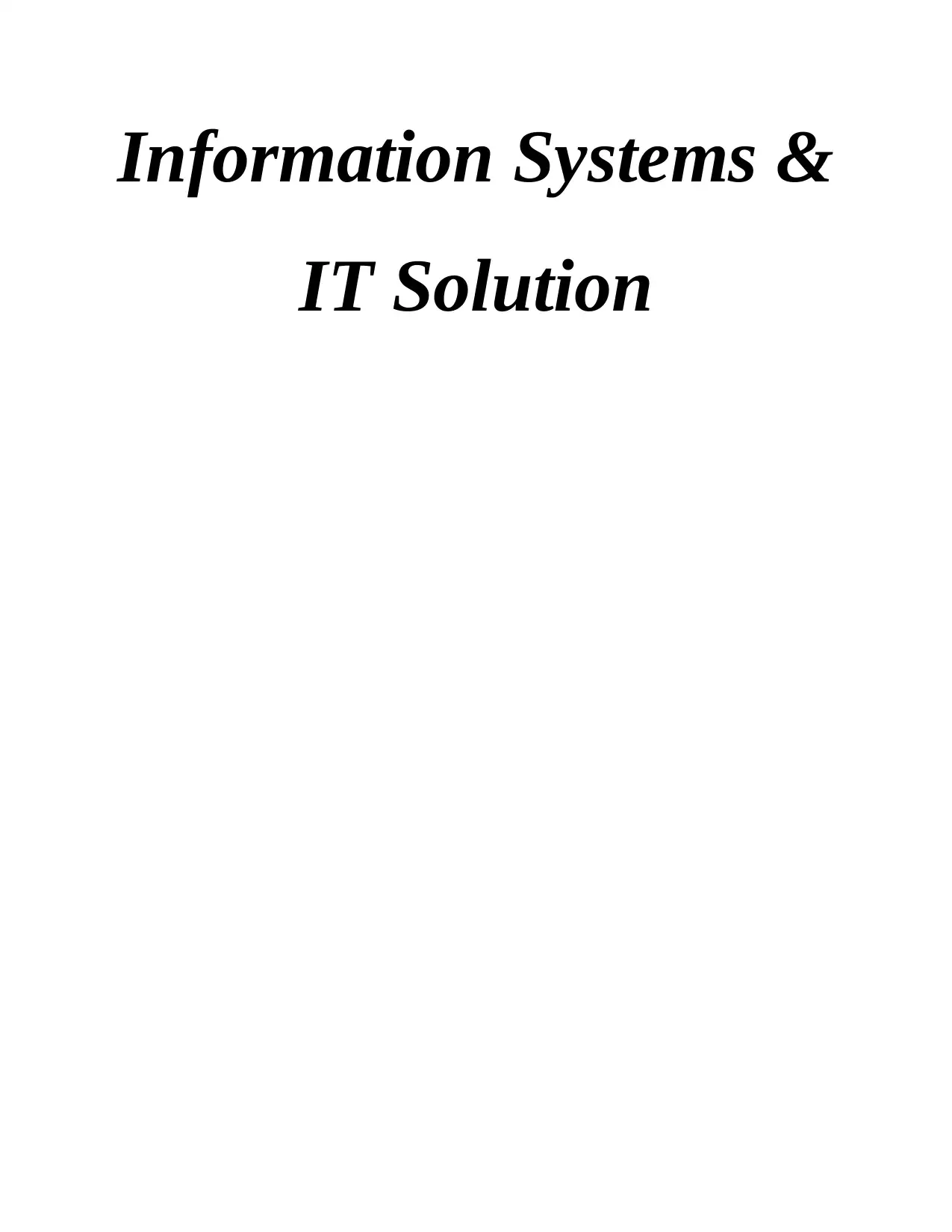
Information Systems &
IT Solution
IT Solution
Paraphrase This Document
Need a fresh take? Get an instant paraphrase of this document with our AI Paraphraser
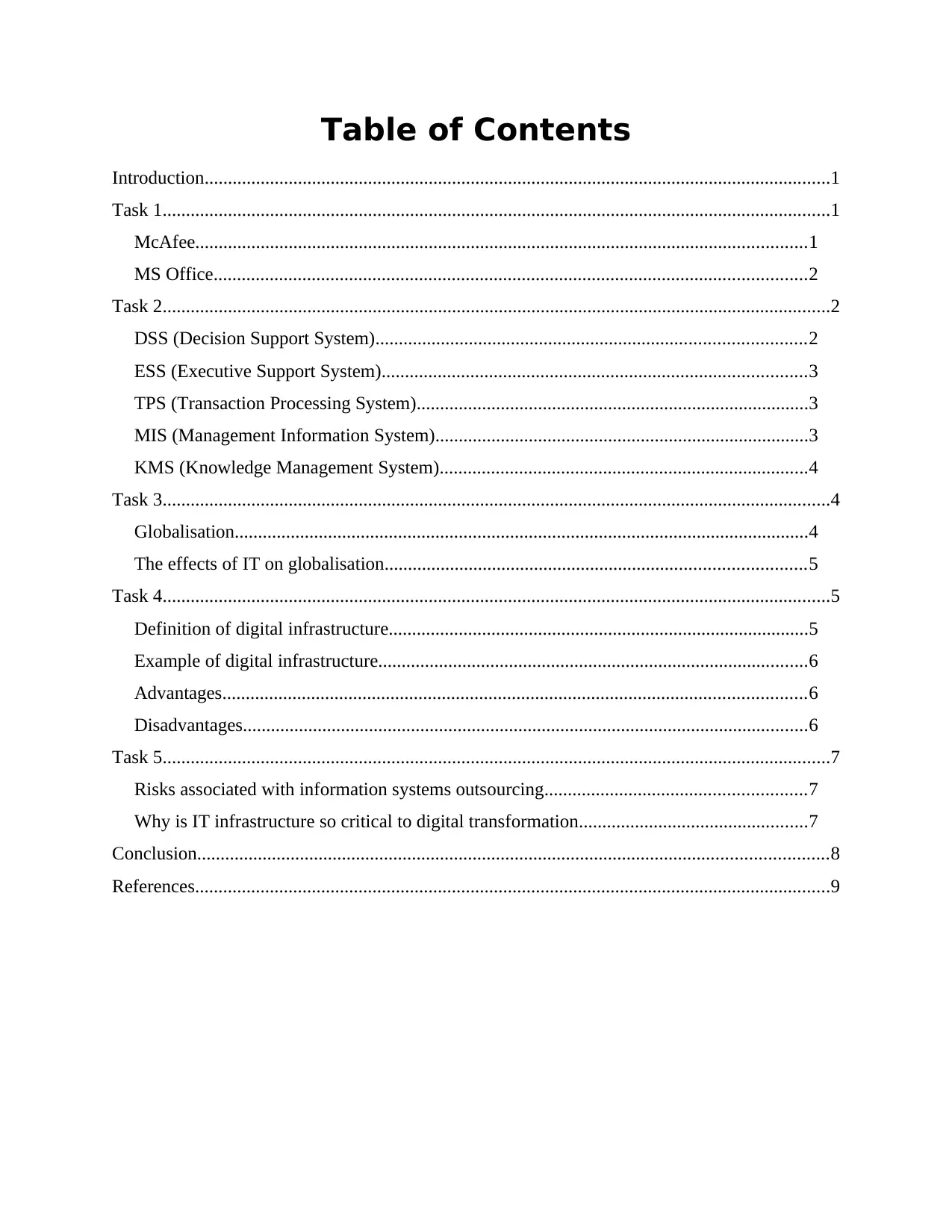
Table of Contents
Introduction......................................................................................................................................1
Task 1...............................................................................................................................................1
McAfee...................................................................................................................................1
MS Office...............................................................................................................................2
Task 2...............................................................................................................................................2
DSS (Decision Support System)............................................................................................2
ESS (Executive Support System)...........................................................................................3
TPS (Transaction Processing System)....................................................................................3
MIS (Management Information System)................................................................................3
KMS (Knowledge Management System)...............................................................................4
Task 3...............................................................................................................................................4
Globalisation...........................................................................................................................4
The effects of IT on globalisation..........................................................................................5
Task 4...............................................................................................................................................5
Definition of digital infrastructure..........................................................................................5
Example of digital infrastructure............................................................................................6
Advantages.............................................................................................................................6
Disadvantages.........................................................................................................................6
Task 5...............................................................................................................................................7
Risks associated with information systems outsourcing........................................................7
Why is IT infrastructure so critical to digital transformation.................................................7
Conclusion.......................................................................................................................................8
References........................................................................................................................................9
Introduction......................................................................................................................................1
Task 1...............................................................................................................................................1
McAfee...................................................................................................................................1
MS Office...............................................................................................................................2
Task 2...............................................................................................................................................2
DSS (Decision Support System)............................................................................................2
ESS (Executive Support System)...........................................................................................3
TPS (Transaction Processing System)....................................................................................3
MIS (Management Information System)................................................................................3
KMS (Knowledge Management System)...............................................................................4
Task 3...............................................................................................................................................4
Globalisation...........................................................................................................................4
The effects of IT on globalisation..........................................................................................5
Task 4...............................................................................................................................................5
Definition of digital infrastructure..........................................................................................5
Example of digital infrastructure............................................................................................6
Advantages.............................................................................................................................6
Disadvantages.........................................................................................................................6
Task 5...............................................................................................................................................7
Risks associated with information systems outsourcing........................................................7
Why is IT infrastructure so critical to digital transformation.................................................7
Conclusion.......................................................................................................................................8
References........................................................................................................................................9
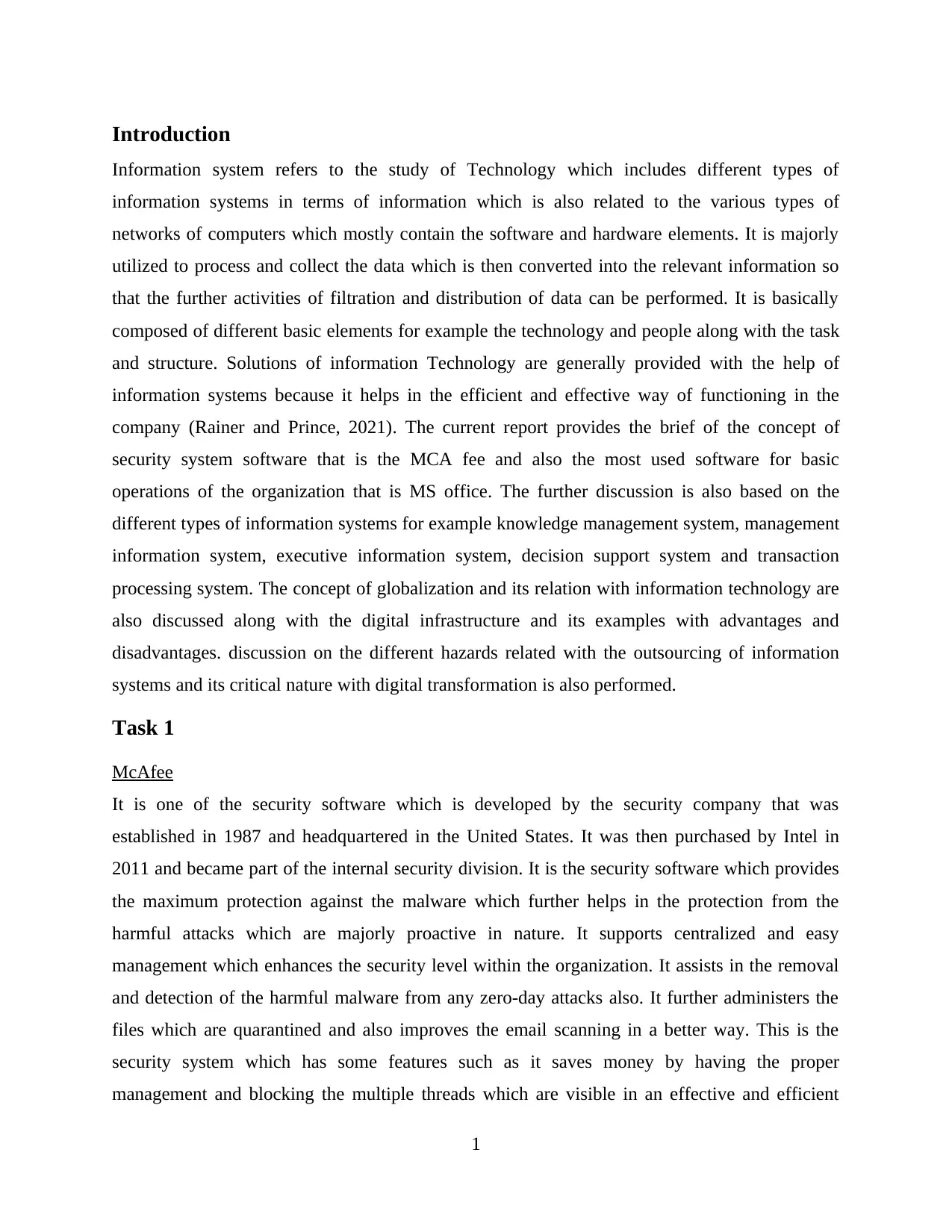
Introduction
Information system refers to the study of Technology which includes different types of
information systems in terms of information which is also related to the various types of
networks of computers which mostly contain the software and hardware elements. It is majorly
utilized to process and collect the data which is then converted into the relevant information so
that the further activities of filtration and distribution of data can be performed. It is basically
composed of different basic elements for example the technology and people along with the task
and structure. Solutions of information Technology are generally provided with the help of
information systems because it helps in the efficient and effective way of functioning in the
company (Rainer and Prince, 2021). The current report provides the brief of the concept of
security system software that is the MCA fee and also the most used software for basic
operations of the organization that is MS office. The further discussion is also based on the
different types of information systems for example knowledge management system, management
information system, executive information system, decision support system and transaction
processing system. The concept of globalization and its relation with information technology are
also discussed along with the digital infrastructure and its examples with advantages and
disadvantages. discussion on the different hazards related with the outsourcing of information
systems and its critical nature with digital transformation is also performed.
Task 1
McAfee
It is one of the security software which is developed by the security company that was
established in 1987 and headquartered in the United States. It was then purchased by Intel in
2011 and became part of the internal security division. It is the security software which provides
the maximum protection against the malware which further helps in the protection from the
harmful attacks which are majorly proactive in nature. It supports centralized and easy
management which enhances the security level within the organization. It assists in the removal
and detection of the harmful malware from any zero-day attacks also. It further administers the
files which are quarantined and also improves the email scanning in a better way. This is the
security system which has some features such as it saves money by having the proper
management and blocking the multiple threads which are visible in an effective and efficient
1
Information system refers to the study of Technology which includes different types of
information systems in terms of information which is also related to the various types of
networks of computers which mostly contain the software and hardware elements. It is majorly
utilized to process and collect the data which is then converted into the relevant information so
that the further activities of filtration and distribution of data can be performed. It is basically
composed of different basic elements for example the technology and people along with the task
and structure. Solutions of information Technology are generally provided with the help of
information systems because it helps in the efficient and effective way of functioning in the
company (Rainer and Prince, 2021). The current report provides the brief of the concept of
security system software that is the MCA fee and also the most used software for basic
operations of the organization that is MS office. The further discussion is also based on the
different types of information systems for example knowledge management system, management
information system, executive information system, decision support system and transaction
processing system. The concept of globalization and its relation with information technology are
also discussed along with the digital infrastructure and its examples with advantages and
disadvantages. discussion on the different hazards related with the outsourcing of information
systems and its critical nature with digital transformation is also performed.
Task 1
McAfee
It is one of the security software which is developed by the security company that was
established in 1987 and headquartered in the United States. It was then purchased by Intel in
2011 and became part of the internal security division. It is the security software which provides
the maximum protection against the malware which further helps in the protection from the
harmful attacks which are majorly proactive in nature. It supports centralized and easy
management which enhances the security level within the organization. It assists in the removal
and detection of the harmful malware from any zero-day attacks also. It further administers the
files which are quarantined and also improves the email scanning in a better way. This is the
security system which has some features such as it saves money by having the proper
management and blocking the multiple threads which are visible in an effective and efficient
1
⊘ This is a preview!⊘
Do you want full access?
Subscribe today to unlock all pages.

Trusted by 1+ million students worldwide
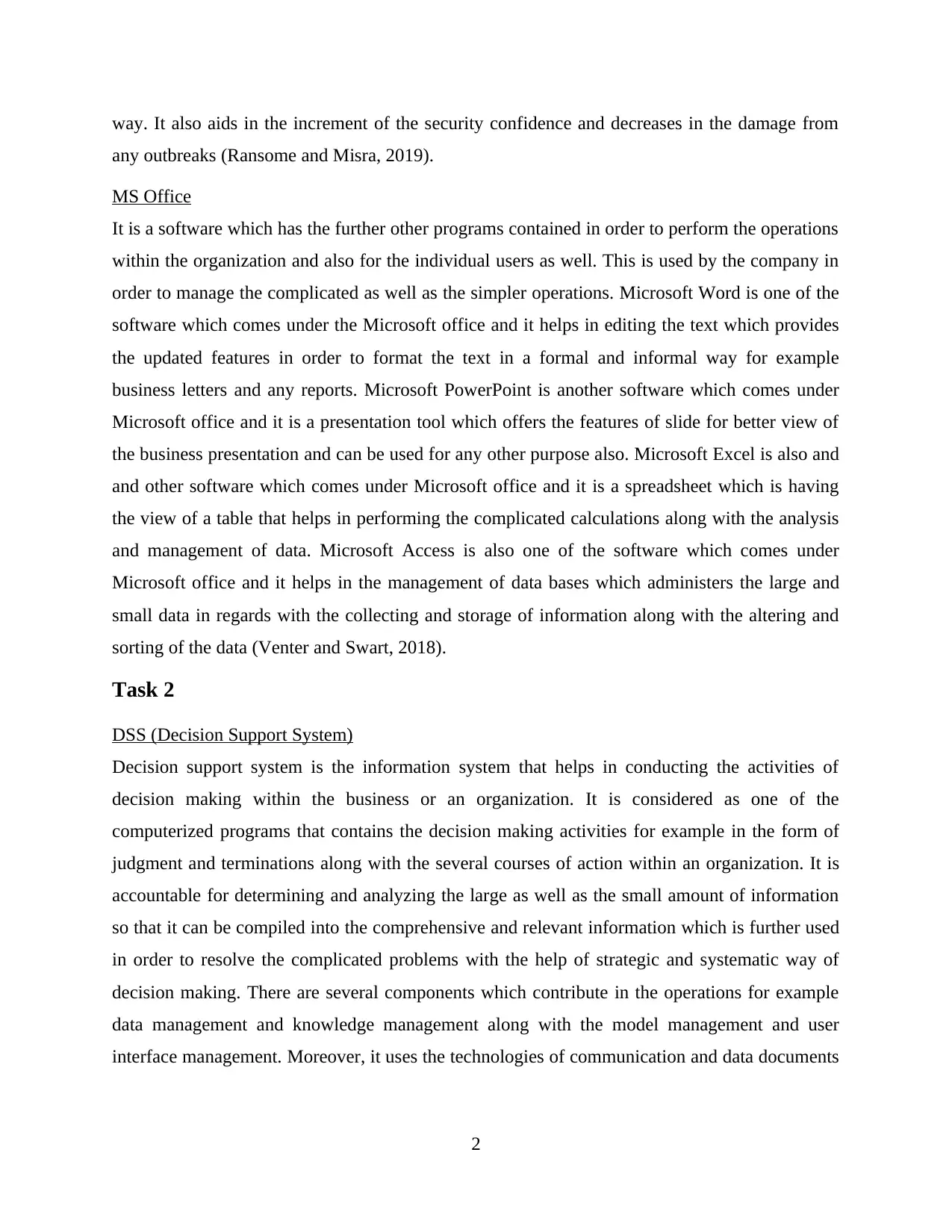
way. It also aids in the increment of the security confidence and decreases in the damage from
any outbreaks (Ransome and Misra, 2019).
MS Office
It is a software which has the further other programs contained in order to perform the operations
within the organization and also for the individual users as well. This is used by the company in
order to manage the complicated as well as the simpler operations. Microsoft Word is one of the
software which comes under the Microsoft office and it helps in editing the text which provides
the updated features in order to format the text in a formal and informal way for example
business letters and any reports. Microsoft PowerPoint is another software which comes under
Microsoft office and it is a presentation tool which offers the features of slide for better view of
the business presentation and can be used for any other purpose also. Microsoft Excel is also and
and other software which comes under Microsoft office and it is a spreadsheet which is having
the view of a table that helps in performing the complicated calculations along with the analysis
and management of data. Microsoft Access is also one of the software which comes under
Microsoft office and it helps in the management of data bases which administers the large and
small data in regards with the collecting and storage of information along with the altering and
sorting of the data (Venter and Swart, 2018).
Task 2
DSS (Decision Support System)
Decision support system is the information system that helps in conducting the activities of
decision making within the business or an organization. It is considered as one of the
computerized programs that contains the decision making activities for example in the form of
judgment and terminations along with the several courses of action within an organization. It is
accountable for determining and analyzing the large as well as the small amount of information
so that it can be compiled into the comprehensive and relevant information which is further used
in order to resolve the complicated problems with the help of strategic and systematic way of
decision making. There are several components which contribute in the operations for example
data management and knowledge management along with the model management and user
interface management. Moreover, it uses the technologies of communication and data documents
2
any outbreaks (Ransome and Misra, 2019).
MS Office
It is a software which has the further other programs contained in order to perform the operations
within the organization and also for the individual users as well. This is used by the company in
order to manage the complicated as well as the simpler operations. Microsoft Word is one of the
software which comes under the Microsoft office and it helps in editing the text which provides
the updated features in order to format the text in a formal and informal way for example
business letters and any reports. Microsoft PowerPoint is another software which comes under
Microsoft office and it is a presentation tool which offers the features of slide for better view of
the business presentation and can be used for any other purpose also. Microsoft Excel is also and
and other software which comes under Microsoft office and it is a spreadsheet which is having
the view of a table that helps in performing the complicated calculations along with the analysis
and management of data. Microsoft Access is also one of the software which comes under
Microsoft office and it helps in the management of data bases which administers the large and
small data in regards with the collecting and storage of information along with the altering and
sorting of the data (Venter and Swart, 2018).
Task 2
DSS (Decision Support System)
Decision support system is the information system that helps in conducting the activities of
decision making within the business or an organization. It is considered as one of the
computerized programs that contains the decision making activities for example in the form of
judgment and terminations along with the several courses of action within an organization. It is
accountable for determining and analyzing the large as well as the small amount of information
so that it can be compiled into the comprehensive and relevant information which is further used
in order to resolve the complicated problems with the help of strategic and systematic way of
decision making. There are several components which contribute in the operations for example
data management and knowledge management along with the model management and user
interface management. Moreover, it uses the technologies of communication and data documents
2
Paraphrase This Document
Need a fresh take? Get an instant paraphrase of this document with our AI Paraphraser
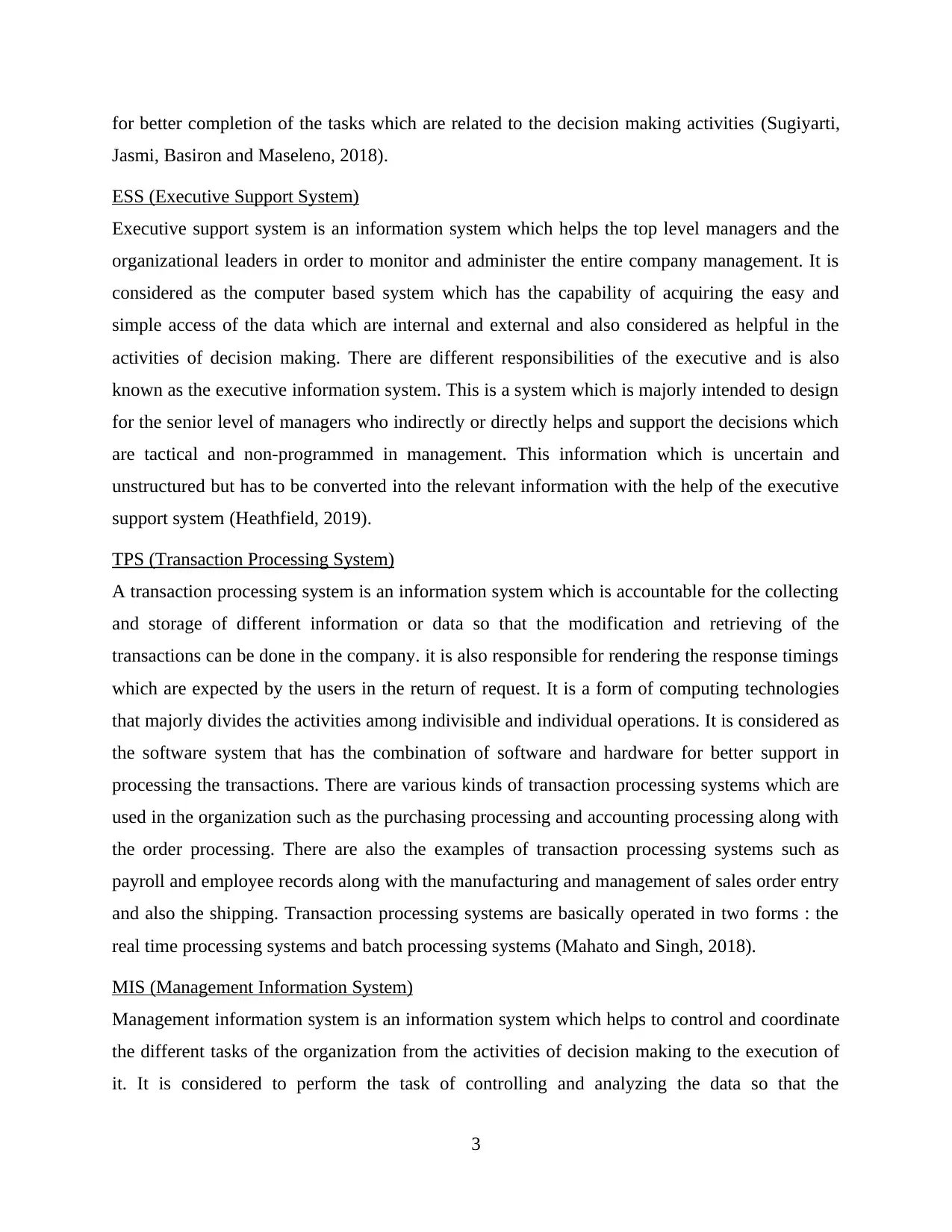
for better completion of the tasks which are related to the decision making activities (Sugiyarti,
Jasmi, Basiron and Maseleno, 2018).
ESS (Executive Support System)
Executive support system is an information system which helps the top level managers and the
organizational leaders in order to monitor and administer the entire company management. It is
considered as the computer based system which has the capability of acquiring the easy and
simple access of the data which are internal and external and also considered as helpful in the
activities of decision making. There are different responsibilities of the executive and is also
known as the executive information system. This is a system which is majorly intended to design
for the senior level of managers who indirectly or directly helps and support the decisions which
are tactical and non-programmed in management. This information which is uncertain and
unstructured but has to be converted into the relevant information with the help of the executive
support system (Heathfield, 2019).
TPS (Transaction Processing System)
A transaction processing system is an information system which is accountable for the collecting
and storage of different information or data so that the modification and retrieving of the
transactions can be done in the company. it is also responsible for rendering the response timings
which are expected by the users in the return of request. It is a form of computing technologies
that majorly divides the activities among indivisible and individual operations. It is considered as
the software system that has the combination of software and hardware for better support in
processing the transactions. There are various kinds of transaction processing systems which are
used in the organization such as the purchasing processing and accounting processing along with
the order processing. There are also the examples of transaction processing systems such as
payroll and employee records along with the manufacturing and management of sales order entry
and also the shipping. Transaction processing systems are basically operated in two forms : the
real time processing systems and batch processing systems (Mahato and Singh, 2018).
MIS (Management Information System)
Management information system is an information system which helps to control and coordinate
the different tasks of the organization from the activities of decision making to the execution of
it. It is considered to perform the task of controlling and analyzing the data so that the
3
Jasmi, Basiron and Maseleno, 2018).
ESS (Executive Support System)
Executive support system is an information system which helps the top level managers and the
organizational leaders in order to monitor and administer the entire company management. It is
considered as the computer based system which has the capability of acquiring the easy and
simple access of the data which are internal and external and also considered as helpful in the
activities of decision making. There are different responsibilities of the executive and is also
known as the executive information system. This is a system which is majorly intended to design
for the senior level of managers who indirectly or directly helps and support the decisions which
are tactical and non-programmed in management. This information which is uncertain and
unstructured but has to be converted into the relevant information with the help of the executive
support system (Heathfield, 2019).
TPS (Transaction Processing System)
A transaction processing system is an information system which is accountable for the collecting
and storage of different information or data so that the modification and retrieving of the
transactions can be done in the company. it is also responsible for rendering the response timings
which are expected by the users in the return of request. It is a form of computing technologies
that majorly divides the activities among indivisible and individual operations. It is considered as
the software system that has the combination of software and hardware for better support in
processing the transactions. There are various kinds of transaction processing systems which are
used in the organization such as the purchasing processing and accounting processing along with
the order processing. There are also the examples of transaction processing systems such as
payroll and employee records along with the manufacturing and management of sales order entry
and also the shipping. Transaction processing systems are basically operated in two forms : the
real time processing systems and batch processing systems (Mahato and Singh, 2018).
MIS (Management Information System)
Management information system is an information system which helps to control and coordinate
the different tasks of the organization from the activities of decision making to the execution of
it. It is considered to perform the task of controlling and analyzing the data so that the
3
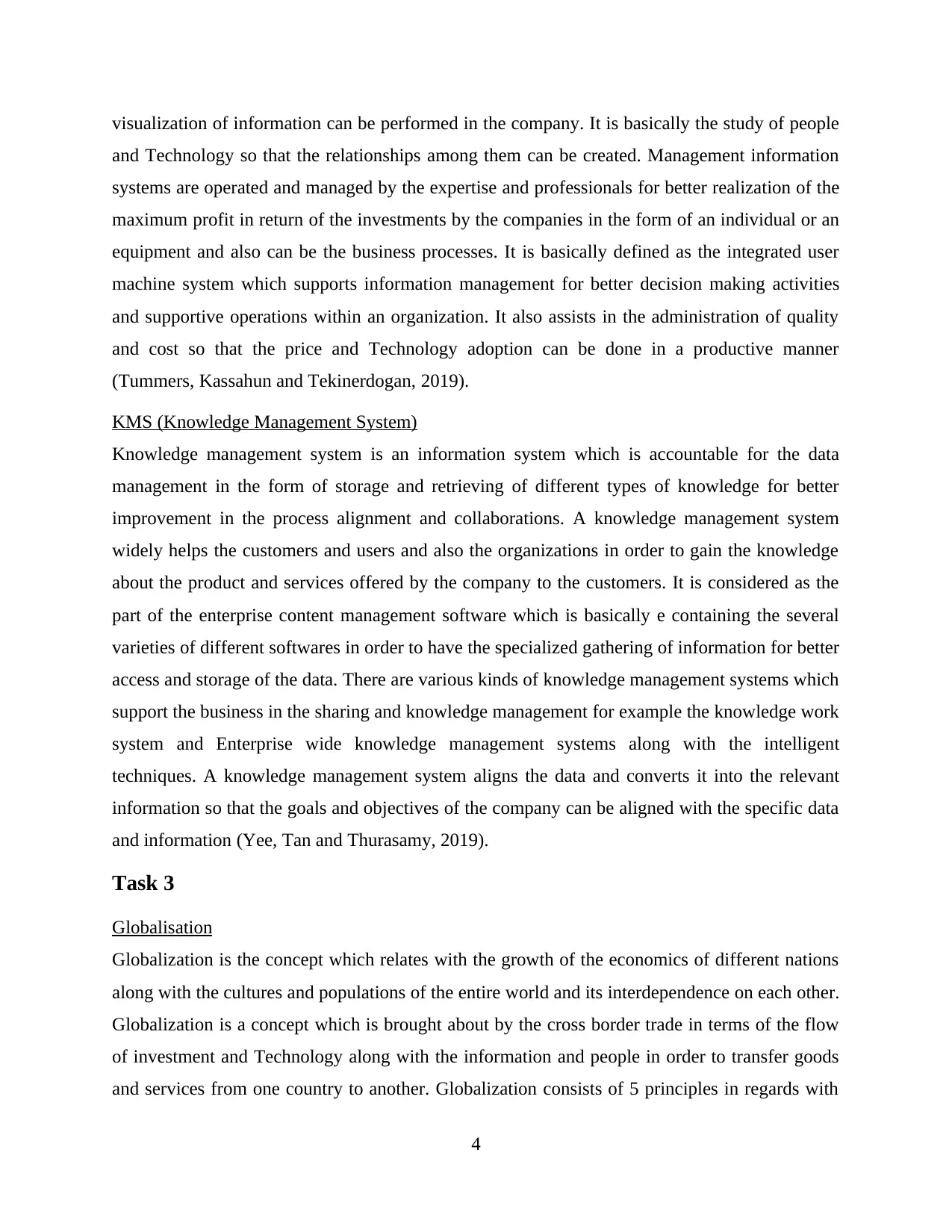
visualization of information can be performed in the company. It is basically the study of people
and Technology so that the relationships among them can be created. Management information
systems are operated and managed by the expertise and professionals for better realization of the
maximum profit in return of the investments by the companies in the form of an individual or an
equipment and also can be the business processes. It is basically defined as the integrated user
machine system which supports information management for better decision making activities
and supportive operations within an organization. It also assists in the administration of quality
and cost so that the price and Technology adoption can be done in a productive manner
(Tummers, Kassahun and Tekinerdogan, 2019).
KMS (Knowledge Management System)
Knowledge management system is an information system which is accountable for the data
management in the form of storage and retrieving of different types of knowledge for better
improvement in the process alignment and collaborations. A knowledge management system
widely helps the customers and users and also the organizations in order to gain the knowledge
about the product and services offered by the company to the customers. It is considered as the
part of the enterprise content management software which is basically e containing the several
varieties of different softwares in order to have the specialized gathering of information for better
access and storage of the data. There are various kinds of knowledge management systems which
support the business in the sharing and knowledge management for example the knowledge work
system and Enterprise wide knowledge management systems along with the intelligent
techniques. A knowledge management system aligns the data and converts it into the relevant
information so that the goals and objectives of the company can be aligned with the specific data
and information (Yee, Tan and Thurasamy, 2019).
Task 3
Globalisation
Globalization is the concept which relates with the growth of the economics of different nations
along with the cultures and populations of the entire world and its interdependence on each other.
Globalization is a concept which is brought about by the cross border trade in terms of the flow
of investment and Technology along with the information and people in order to transfer goods
and services from one country to another. Globalization consists of 5 principles in regards with
4
and Technology so that the relationships among them can be created. Management information
systems are operated and managed by the expertise and professionals for better realization of the
maximum profit in return of the investments by the companies in the form of an individual or an
equipment and also can be the business processes. It is basically defined as the integrated user
machine system which supports information management for better decision making activities
and supportive operations within an organization. It also assists in the administration of quality
and cost so that the price and Technology adoption can be done in a productive manner
(Tummers, Kassahun and Tekinerdogan, 2019).
KMS (Knowledge Management System)
Knowledge management system is an information system which is accountable for the data
management in the form of storage and retrieving of different types of knowledge for better
improvement in the process alignment and collaborations. A knowledge management system
widely helps the customers and users and also the organizations in order to gain the knowledge
about the product and services offered by the company to the customers. It is considered as the
part of the enterprise content management software which is basically e containing the several
varieties of different softwares in order to have the specialized gathering of information for better
access and storage of the data. There are various kinds of knowledge management systems which
support the business in the sharing and knowledge management for example the knowledge work
system and Enterprise wide knowledge management systems along with the intelligent
techniques. A knowledge management system aligns the data and converts it into the relevant
information so that the goals and objectives of the company can be aligned with the specific data
and information (Yee, Tan and Thurasamy, 2019).
Task 3
Globalisation
Globalization is the concept which relates with the growth of the economics of different nations
along with the cultures and populations of the entire world and its interdependence on each other.
Globalization is a concept which is brought about by the cross border trade in terms of the flow
of investment and Technology along with the information and people in order to transfer goods
and services from one country to another. Globalization consists of 5 principles in regards with
4
⊘ This is a preview!⊘
Do you want full access?
Subscribe today to unlock all pages.

Trusted by 1+ million students worldwide
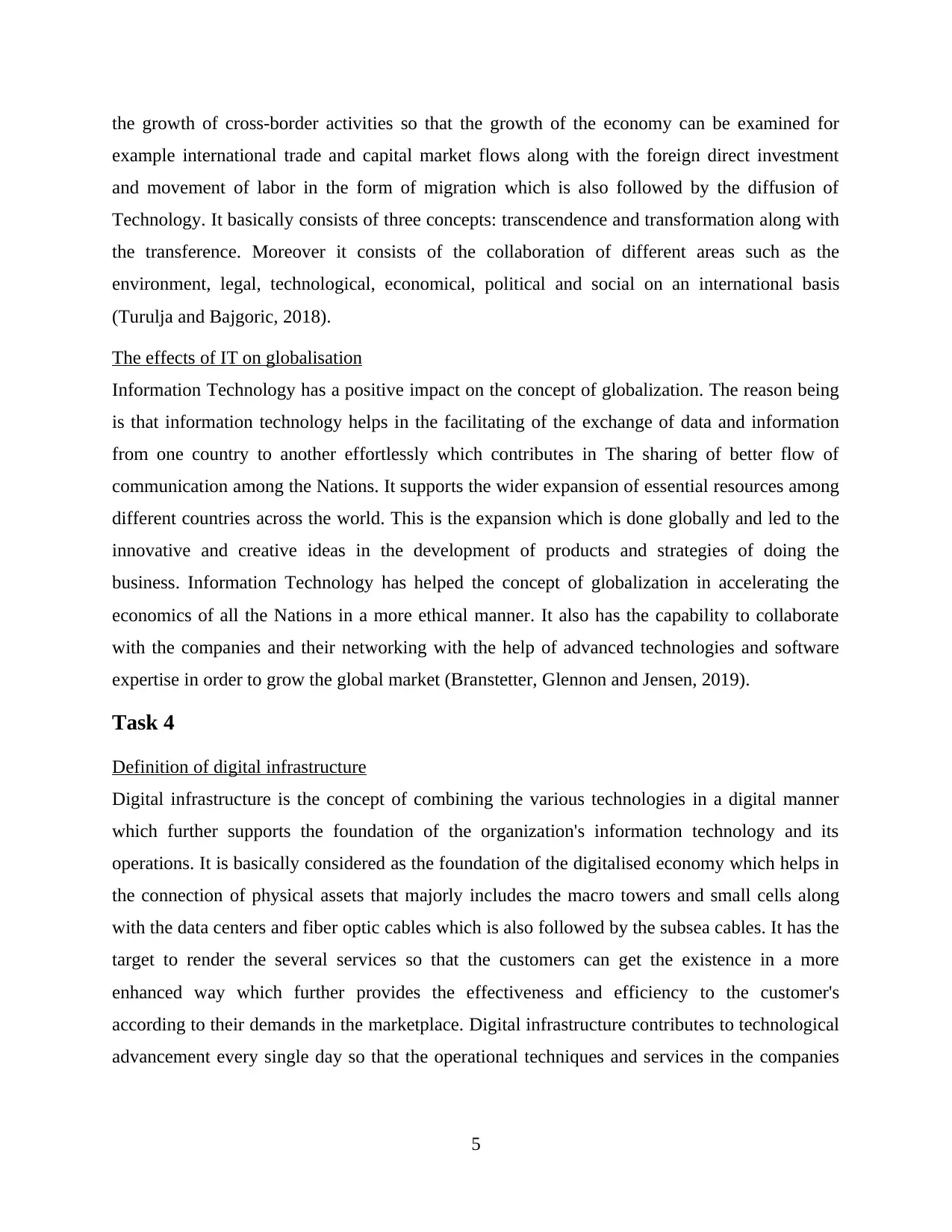
the growth of cross-border activities so that the growth of the economy can be examined for
example international trade and capital market flows along with the foreign direct investment
and movement of labor in the form of migration which is also followed by the diffusion of
Technology. It basically consists of three concepts: transcendence and transformation along with
the transference. Moreover it consists of the collaboration of different areas such as the
environment, legal, technological, economical, political and social on an international basis
(Turulja and Bajgoric, 2018).
The effects of IT on globalisation
Information Technology has a positive impact on the concept of globalization. The reason being
is that information technology helps in the facilitating of the exchange of data and information
from one country to another effortlessly which contributes in The sharing of better flow of
communication among the Nations. It supports the wider expansion of essential resources among
different countries across the world. This is the expansion which is done globally and led to the
innovative and creative ideas in the development of products and strategies of doing the
business. Information Technology has helped the concept of globalization in accelerating the
economics of all the Nations in a more ethical manner. It also has the capability to collaborate
with the companies and their networking with the help of advanced technologies and software
expertise in order to grow the global market (Branstetter, Glennon and Jensen, 2019).
Task 4
Definition of digital infrastructure
Digital infrastructure is the concept of combining the various technologies in a digital manner
which further supports the foundation of the organization's information technology and its
operations. It is basically considered as the foundation of the digitalised economy which helps in
the connection of physical assets that majorly includes the macro towers and small cells along
with the data centers and fiber optic cables which is also followed by the subsea cables. It has the
target to render the several services so that the customers can get the existence in a more
enhanced way which further provides the effectiveness and efficiency to the customer's
according to their demands in the marketplace. Digital infrastructure contributes to technological
advancement every single day so that the operational techniques and services in the companies
5
example international trade and capital market flows along with the foreign direct investment
and movement of labor in the form of migration which is also followed by the diffusion of
Technology. It basically consists of three concepts: transcendence and transformation along with
the transference. Moreover it consists of the collaboration of different areas such as the
environment, legal, technological, economical, political and social on an international basis
(Turulja and Bajgoric, 2018).
The effects of IT on globalisation
Information Technology has a positive impact on the concept of globalization. The reason being
is that information technology helps in the facilitating of the exchange of data and information
from one country to another effortlessly which contributes in The sharing of better flow of
communication among the Nations. It supports the wider expansion of essential resources among
different countries across the world. This is the expansion which is done globally and led to the
innovative and creative ideas in the development of products and strategies of doing the
business. Information Technology has helped the concept of globalization in accelerating the
economics of all the Nations in a more ethical manner. It also has the capability to collaborate
with the companies and their networking with the help of advanced technologies and software
expertise in order to grow the global market (Branstetter, Glennon and Jensen, 2019).
Task 4
Definition of digital infrastructure
Digital infrastructure is the concept of combining the various technologies in a digital manner
which further supports the foundation of the organization's information technology and its
operations. It is basically considered as the foundation of the digitalised economy which helps in
the connection of physical assets that majorly includes the macro towers and small cells along
with the data centers and fiber optic cables which is also followed by the subsea cables. It has the
target to render the several services so that the customers can get the existence in a more
enhanced way which further provides the effectiveness and efficiency to the customer's
according to their demands in the marketplace. Digital infrastructure contributes to technological
advancement every single day so that the operational techniques and services in the companies
5
Paraphrase This Document
Need a fresh take? Get an instant paraphrase of this document with our AI Paraphraser
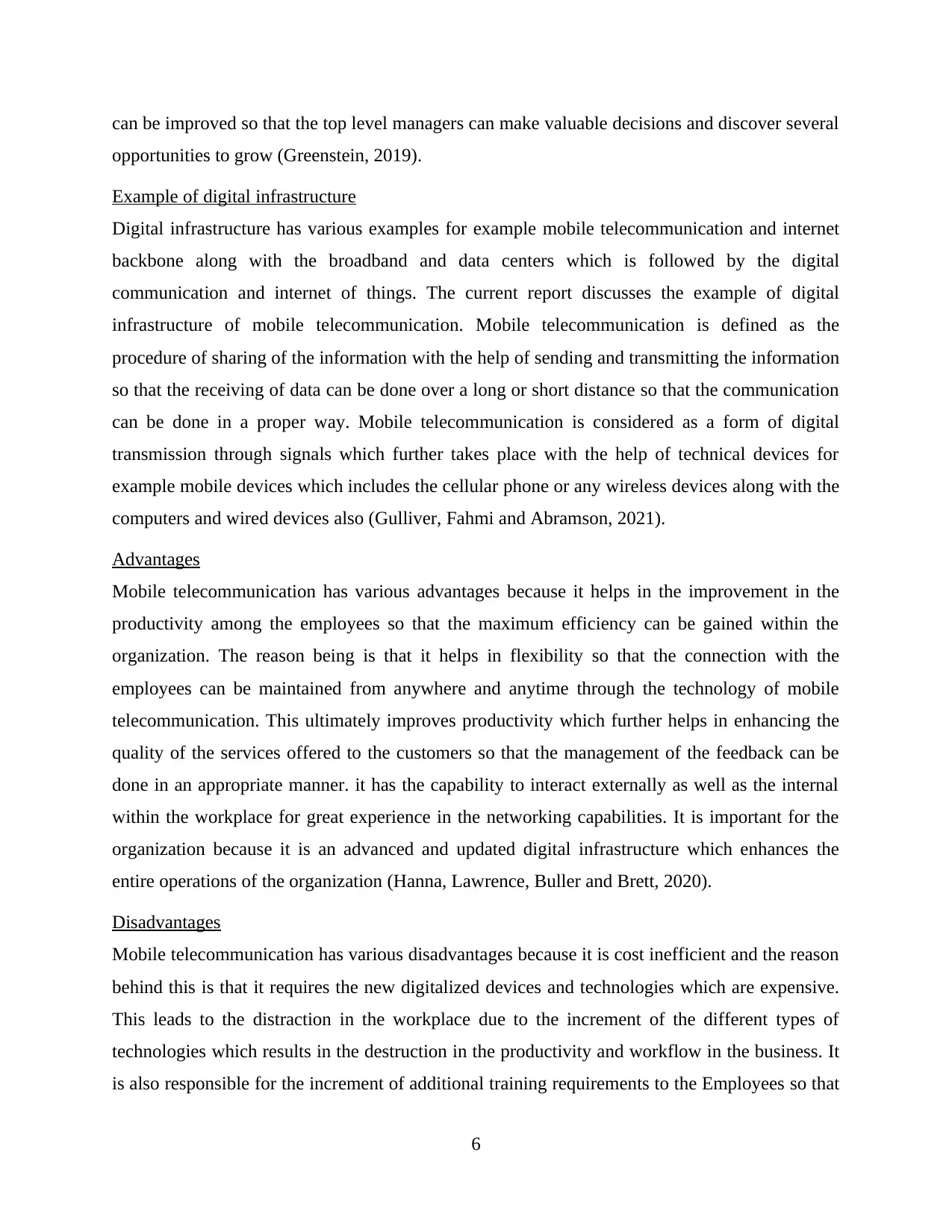
can be improved so that the top level managers can make valuable decisions and discover several
opportunities to grow (Greenstein, 2019).
Example of digital infrastructure
Digital infrastructure has various examples for example mobile telecommunication and internet
backbone along with the broadband and data centers which is followed by the digital
communication and internet of things. The current report discusses the example of digital
infrastructure of mobile telecommunication. Mobile telecommunication is defined as the
procedure of sharing of the information with the help of sending and transmitting the information
so that the receiving of data can be done over a long or short distance so that the communication
can be done in a proper way. Mobile telecommunication is considered as a form of digital
transmission through signals which further takes place with the help of technical devices for
example mobile devices which includes the cellular phone or any wireless devices along with the
computers and wired devices also (Gulliver, Fahmi and Abramson, 2021).
Advantages
Mobile telecommunication has various advantages because it helps in the improvement in the
productivity among the employees so that the maximum efficiency can be gained within the
organization. The reason being is that it helps in flexibility so that the connection with the
employees can be maintained from anywhere and anytime through the technology of mobile
telecommunication. This ultimately improves productivity which further helps in enhancing the
quality of the services offered to the customers so that the management of the feedback can be
done in an appropriate manner. it has the capability to interact externally as well as the internal
within the workplace for great experience in the networking capabilities. It is important for the
organization because it is an advanced and updated digital infrastructure which enhances the
entire operations of the organization (Hanna, Lawrence, Buller and Brett, 2020).
Disadvantages
Mobile telecommunication has various disadvantages because it is cost inefficient and the reason
behind this is that it requires the new digitalized devices and technologies which are expensive.
This leads to the distraction in the workplace due to the increment of the different types of
technologies which results in the destruction in the productivity and workflow in the business. It
is also responsible for the increment of additional training requirements to the Employees so that
6
opportunities to grow (Greenstein, 2019).
Example of digital infrastructure
Digital infrastructure has various examples for example mobile telecommunication and internet
backbone along with the broadband and data centers which is followed by the digital
communication and internet of things. The current report discusses the example of digital
infrastructure of mobile telecommunication. Mobile telecommunication is defined as the
procedure of sharing of the information with the help of sending and transmitting the information
so that the receiving of data can be done over a long or short distance so that the communication
can be done in a proper way. Mobile telecommunication is considered as a form of digital
transmission through signals which further takes place with the help of technical devices for
example mobile devices which includes the cellular phone or any wireless devices along with the
computers and wired devices also (Gulliver, Fahmi and Abramson, 2021).
Advantages
Mobile telecommunication has various advantages because it helps in the improvement in the
productivity among the employees so that the maximum efficiency can be gained within the
organization. The reason being is that it helps in flexibility so that the connection with the
employees can be maintained from anywhere and anytime through the technology of mobile
telecommunication. This ultimately improves productivity which further helps in enhancing the
quality of the services offered to the customers so that the management of the feedback can be
done in an appropriate manner. it has the capability to interact externally as well as the internal
within the workplace for great experience in the networking capabilities. It is important for the
organization because it is an advanced and updated digital infrastructure which enhances the
entire operations of the organization (Hanna, Lawrence, Buller and Brett, 2020).
Disadvantages
Mobile telecommunication has various disadvantages because it is cost inefficient and the reason
behind this is that it requires the new digitalized devices and technologies which are expensive.
This leads to the distraction in the workplace due to the increment of the different types of
technologies which results in the destruction in the productivity and workflow in the business. It
is also responsible for the increment of additional training requirements to the Employees so that
6
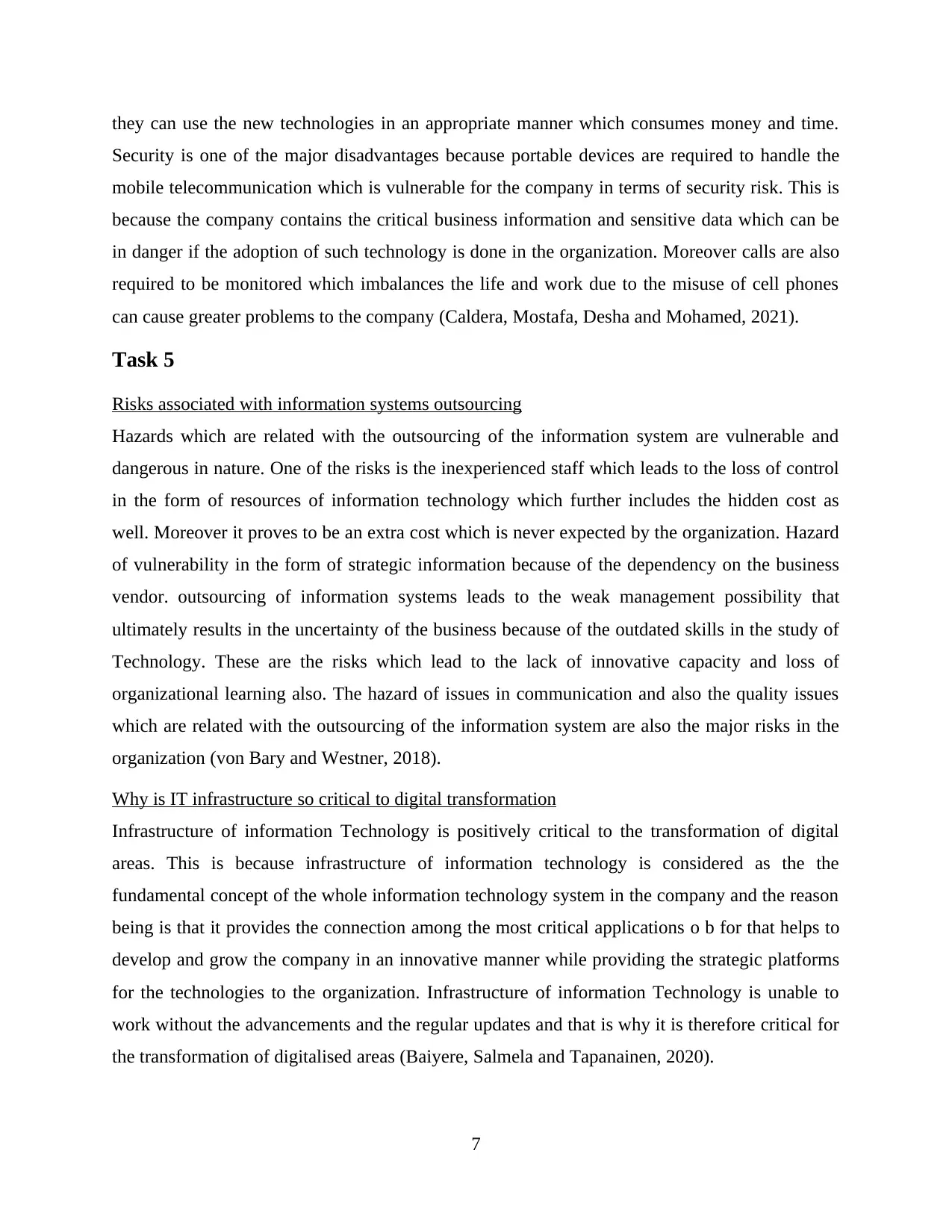
they can use the new technologies in an appropriate manner which consumes money and time.
Security is one of the major disadvantages because portable devices are required to handle the
mobile telecommunication which is vulnerable for the company in terms of security risk. This is
because the company contains the critical business information and sensitive data which can be
in danger if the adoption of such technology is done in the organization. Moreover calls are also
required to be monitored which imbalances the life and work due to the misuse of cell phones
can cause greater problems to the company (Caldera, Mostafa, Desha and Mohamed, 2021).
Task 5
Risks associated with information systems outsourcing
Hazards which are related with the outsourcing of the information system are vulnerable and
dangerous in nature. One of the risks is the inexperienced staff which leads to the loss of control
in the form of resources of information technology which further includes the hidden cost as
well. Moreover it proves to be an extra cost which is never expected by the organization. Hazard
of vulnerability in the form of strategic information because of the dependency on the business
vendor. outsourcing of information systems leads to the weak management possibility that
ultimately results in the uncertainty of the business because of the outdated skills in the study of
Technology. These are the risks which lead to the lack of innovative capacity and loss of
organizational learning also. The hazard of issues in communication and also the quality issues
which are related with the outsourcing of the information system are also the major risks in the
organization (von Bary and Westner, 2018).
Why is IT infrastructure so critical to digital transformation
Infrastructure of information Technology is positively critical to the transformation of digital
areas. This is because infrastructure of information technology is considered as the the
fundamental concept of the whole information technology system in the company and the reason
being is that it provides the connection among the most critical applications o b for that helps to
develop and grow the company in an innovative manner while providing the strategic platforms
for the technologies to the organization. Infrastructure of information Technology is unable to
work without the advancements and the regular updates and that is why it is therefore critical for
the transformation of digitalised areas (Baiyere, Salmela and Tapanainen, 2020).
7
Security is one of the major disadvantages because portable devices are required to handle the
mobile telecommunication which is vulnerable for the company in terms of security risk. This is
because the company contains the critical business information and sensitive data which can be
in danger if the adoption of such technology is done in the organization. Moreover calls are also
required to be monitored which imbalances the life and work due to the misuse of cell phones
can cause greater problems to the company (Caldera, Mostafa, Desha and Mohamed, 2021).
Task 5
Risks associated with information systems outsourcing
Hazards which are related with the outsourcing of the information system are vulnerable and
dangerous in nature. One of the risks is the inexperienced staff which leads to the loss of control
in the form of resources of information technology which further includes the hidden cost as
well. Moreover it proves to be an extra cost which is never expected by the organization. Hazard
of vulnerability in the form of strategic information because of the dependency on the business
vendor. outsourcing of information systems leads to the weak management possibility that
ultimately results in the uncertainty of the business because of the outdated skills in the study of
Technology. These are the risks which lead to the lack of innovative capacity and loss of
organizational learning also. The hazard of issues in communication and also the quality issues
which are related with the outsourcing of the information system are also the major risks in the
organization (von Bary and Westner, 2018).
Why is IT infrastructure so critical to digital transformation
Infrastructure of information Technology is positively critical to the transformation of digital
areas. This is because infrastructure of information technology is considered as the the
fundamental concept of the whole information technology system in the company and the reason
being is that it provides the connection among the most critical applications o b for that helps to
develop and grow the company in an innovative manner while providing the strategic platforms
for the technologies to the organization. Infrastructure of information Technology is unable to
work without the advancements and the regular updates and that is why it is therefore critical for
the transformation of digitalised areas (Baiyere, Salmela and Tapanainen, 2020).
7
⊘ This is a preview!⊘
Do you want full access?
Subscribe today to unlock all pages.

Trusted by 1+ million students worldwide
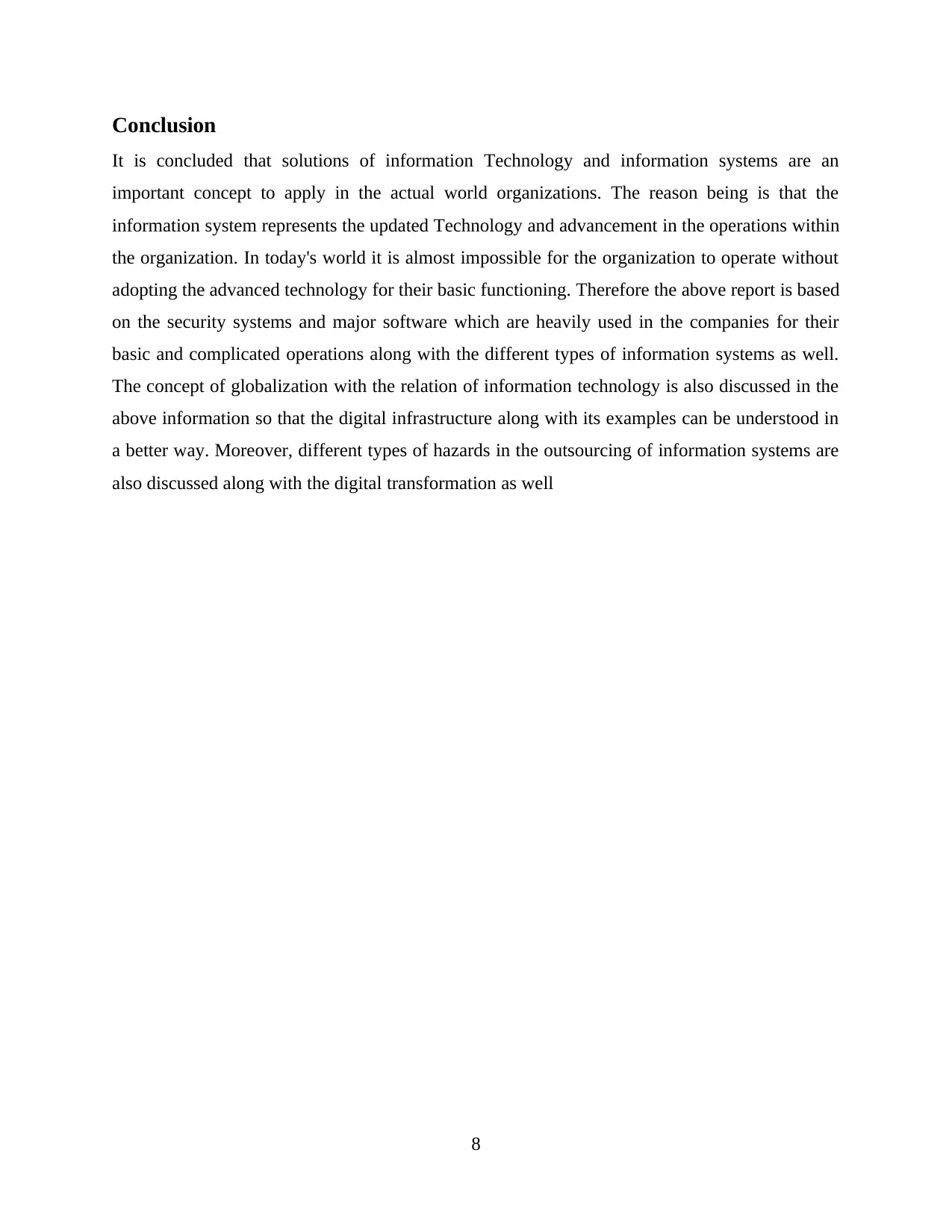
Conclusion
It is concluded that solutions of information Technology and information systems are an
important concept to apply in the actual world organizations. The reason being is that the
information system represents the updated Technology and advancement in the operations within
the organization. In today's world it is almost impossible for the organization to operate without
adopting the advanced technology for their basic functioning. Therefore the above report is based
on the security systems and major software which are heavily used in the companies for their
basic and complicated operations along with the different types of information systems as well.
The concept of globalization with the relation of information technology is also discussed in the
above information so that the digital infrastructure along with its examples can be understood in
a better way. Moreover, different types of hazards in the outsourcing of information systems are
also discussed along with the digital transformation as well
8
It is concluded that solutions of information Technology and information systems are an
important concept to apply in the actual world organizations. The reason being is that the
information system represents the updated Technology and advancement in the operations within
the organization. In today's world it is almost impossible for the organization to operate without
adopting the advanced technology for their basic functioning. Therefore the above report is based
on the security systems and major software which are heavily used in the companies for their
basic and complicated operations along with the different types of information systems as well.
The concept of globalization with the relation of information technology is also discussed in the
above information so that the digital infrastructure along with its examples can be understood in
a better way. Moreover, different types of hazards in the outsourcing of information systems are
also discussed along with the digital transformation as well
8
Paraphrase This Document
Need a fresh take? Get an instant paraphrase of this document with our AI Paraphraser
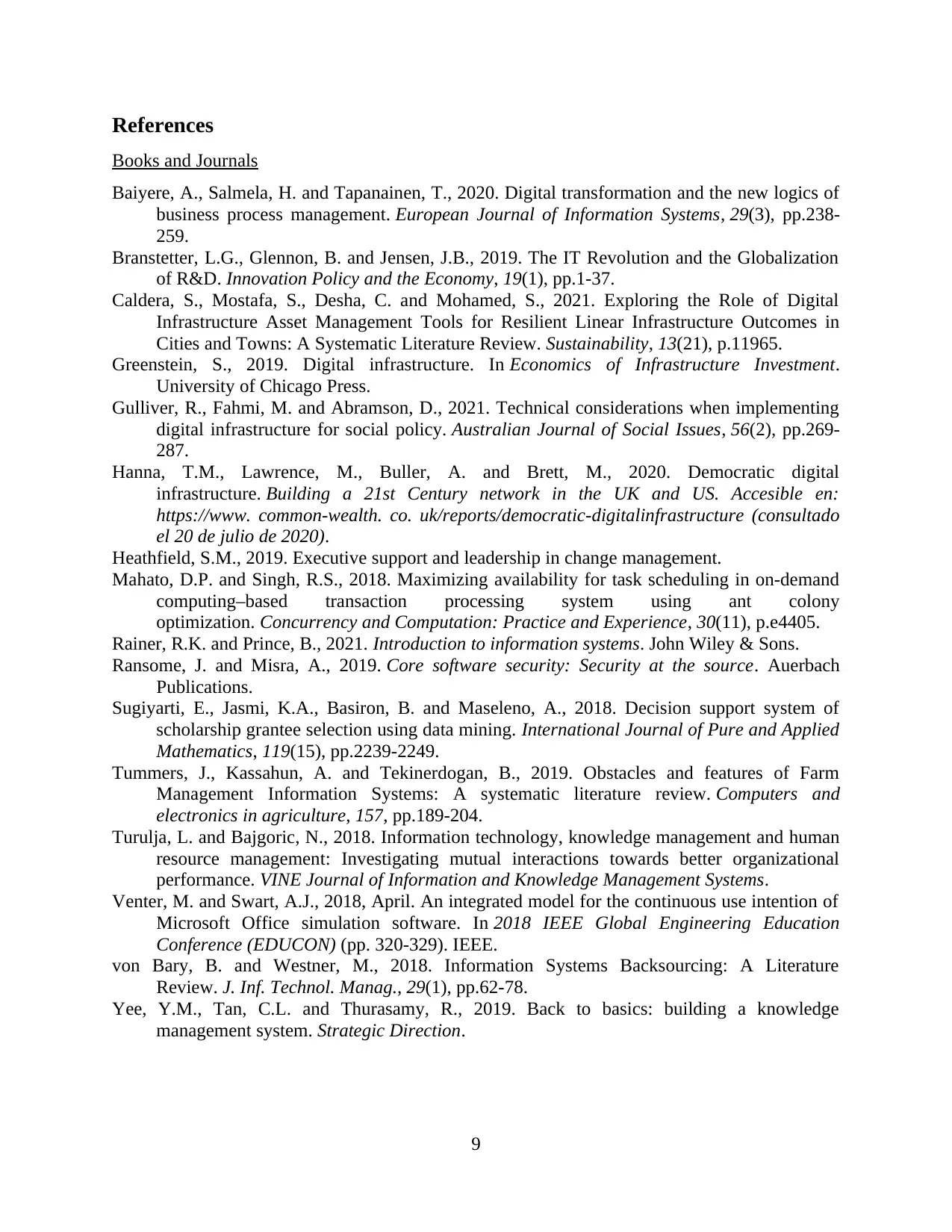
References
Books and Journals
Baiyere, A., Salmela, H. and Tapanainen, T., 2020. Digital transformation and the new logics of
business process management. European Journal of Information Systems, 29(3), pp.238-
259.
Branstetter, L.G., Glennon, B. and Jensen, J.B., 2019. The IT Revolution and the Globalization
of R&D. Innovation Policy and the Economy, 19(1), pp.1-37.
Caldera, S., Mostafa, S., Desha, C. and Mohamed, S., 2021. Exploring the Role of Digital
Infrastructure Asset Management Tools for Resilient Linear Infrastructure Outcomes in
Cities and Towns: A Systematic Literature Review. Sustainability, 13(21), p.11965.
Greenstein, S., 2019. Digital infrastructure. In Economics of Infrastructure Investment.
University of Chicago Press.
Gulliver, R., Fahmi, M. and Abramson, D., 2021. Technical considerations when implementing
digital infrastructure for social policy. Australian Journal of Social Issues, 56(2), pp.269-
287.
Hanna, T.M., Lawrence, M., Buller, A. and Brett, M., 2020. Democratic digital
infrastructure. Building a 21st Century network in the UK and US. Accesible en:
https://www. common-wealth. co. uk/reports/democratic-digitalinfrastructure (consultado
el 20 de julio de 2020).
Heathfield, S.M., 2019. Executive support and leadership in change management.
Mahato, D.P. and Singh, R.S., 2018. Maximizing availability for task scheduling in on‐demand
computing–based transaction processing system using ant colony
optimization. Concurrency and Computation: Practice and Experience, 30(11), p.e4405.
Rainer, R.K. and Prince, B., 2021. Introduction to information systems. John Wiley & Sons.
Ransome, J. and Misra, A., 2019. Core software security: Security at the source. Auerbach
Publications.
Sugiyarti, E., Jasmi, K.A., Basiron, B. and Maseleno, A., 2018. Decision support system of
scholarship grantee selection using data mining. International Journal of Pure and Applied
Mathematics, 119(15), pp.2239-2249.
Tummers, J., Kassahun, A. and Tekinerdogan, B., 2019. Obstacles and features of Farm
Management Information Systems: A systematic literature review. Computers and
electronics in agriculture, 157, pp.189-204.
Turulja, L. and Bajgoric, N., 2018. Information technology, knowledge management and human
resource management: Investigating mutual interactions towards better organizational
performance. VINE Journal of Information and Knowledge Management Systems.
Venter, M. and Swart, A.J., 2018, April. An integrated model for the continuous use intention of
Microsoft Office simulation software. In 2018 IEEE Global Engineering Education
Conference (EDUCON) (pp. 320-329). IEEE.
von Bary, B. and Westner, M., 2018. Information Systems Backsourcing: A Literature
Review. J. Inf. Technol. Manag., 29(1), pp.62-78.
Yee, Y.M., Tan, C.L. and Thurasamy, R., 2019. Back to basics: building a knowledge
management system. Strategic Direction.
9
Books and Journals
Baiyere, A., Salmela, H. and Tapanainen, T., 2020. Digital transformation and the new logics of
business process management. European Journal of Information Systems, 29(3), pp.238-
259.
Branstetter, L.G., Glennon, B. and Jensen, J.B., 2019. The IT Revolution and the Globalization
of R&D. Innovation Policy and the Economy, 19(1), pp.1-37.
Caldera, S., Mostafa, S., Desha, C. and Mohamed, S., 2021. Exploring the Role of Digital
Infrastructure Asset Management Tools for Resilient Linear Infrastructure Outcomes in
Cities and Towns: A Systematic Literature Review. Sustainability, 13(21), p.11965.
Greenstein, S., 2019. Digital infrastructure. In Economics of Infrastructure Investment.
University of Chicago Press.
Gulliver, R., Fahmi, M. and Abramson, D., 2021. Technical considerations when implementing
digital infrastructure for social policy. Australian Journal of Social Issues, 56(2), pp.269-
287.
Hanna, T.M., Lawrence, M., Buller, A. and Brett, M., 2020. Democratic digital
infrastructure. Building a 21st Century network in the UK and US. Accesible en:
https://www. common-wealth. co. uk/reports/democratic-digitalinfrastructure (consultado
el 20 de julio de 2020).
Heathfield, S.M., 2019. Executive support and leadership in change management.
Mahato, D.P. and Singh, R.S., 2018. Maximizing availability for task scheduling in on‐demand
computing–based transaction processing system using ant colony
optimization. Concurrency and Computation: Practice and Experience, 30(11), p.e4405.
Rainer, R.K. and Prince, B., 2021. Introduction to information systems. John Wiley & Sons.
Ransome, J. and Misra, A., 2019. Core software security: Security at the source. Auerbach
Publications.
Sugiyarti, E., Jasmi, K.A., Basiron, B. and Maseleno, A., 2018. Decision support system of
scholarship grantee selection using data mining. International Journal of Pure and Applied
Mathematics, 119(15), pp.2239-2249.
Tummers, J., Kassahun, A. and Tekinerdogan, B., 2019. Obstacles and features of Farm
Management Information Systems: A systematic literature review. Computers and
electronics in agriculture, 157, pp.189-204.
Turulja, L. and Bajgoric, N., 2018. Information technology, knowledge management and human
resource management: Investigating mutual interactions towards better organizational
performance. VINE Journal of Information and Knowledge Management Systems.
Venter, M. and Swart, A.J., 2018, April. An integrated model for the continuous use intention of
Microsoft Office simulation software. In 2018 IEEE Global Engineering Education
Conference (EDUCON) (pp. 320-329). IEEE.
von Bary, B. and Westner, M., 2018. Information Systems Backsourcing: A Literature
Review. J. Inf. Technol. Manag., 29(1), pp.62-78.
Yee, Y.M., Tan, C.L. and Thurasamy, R., 2019. Back to basics: building a knowledge
management system. Strategic Direction.
9
1 out of 11
Related Documents
Your All-in-One AI-Powered Toolkit for Academic Success.
+13062052269
info@desklib.com
Available 24*7 on WhatsApp / Email
![[object Object]](/_next/static/media/star-bottom.7253800d.svg)
Unlock your academic potential
Copyright © 2020–2025 A2Z Services. All Rights Reserved. Developed and managed by ZUCOL.



